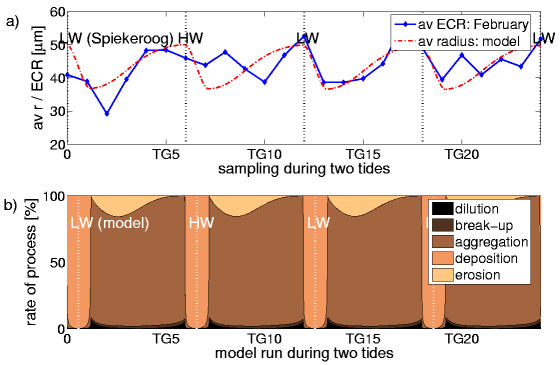
BioGeoChemistry of Tidal Flats
Modeling the suspended particulate matter (SPM) dynamics in the Wadden Sea
In turbulent shallow waters like the Wadden Sea, SPM dynamics is a major determinant of the benthic-pelagic coupling and coastal morphodynamics. SPM consists of small amorphous aggregates which are composed of inorganic and organic matter. These aggregates are microhabitats for microorganisms which decompose and remineralize organic substances and, thus, play an important role in the mirobial loop and for this reason in the marine ecosystem. Their concentration, biological quality as well as the size of aggregates undergo strong fluctuations on various time scales.
In view of estimate the driving processes of SPM dynamics a new approach of model type originated in sub-project 2 will be further developed in cooperation of sub-project 1 and 2. The currently zero-dimensional model explicitly addresses key SPM properties such as average aggregate radius without the need of simulating different size classes, for example. The new model takes the following processes into account: turbulence driven aggregation and disaggregation plus dilution, deposition and erosion of SPM.
As can be seen from figures 1 and 2 the model shows the qualitative behaviour of the average aggregate radius observed by M. Lunau (sub-project 5) in a winter and a summer situation. The relative ratio of the forcing processes is changing within a tide and the annual cycle. Between the turns of the tide aggregation and disaggregation of SPM and resuspension of benthic fluff are the forcing processes. During the turn of the tide turbulence is not strong enough to keep SPM in suspension. For this reason deposition of SPM is the major process which leads to a decrease of the average radius during that time.
In the summer situation, aggregates are more sticky and porous than in winter. Aggregation and disaggregation occurs during times of high turbulence. In winter aggregates are less porous and internal binding forces are stronger so the break-up rate is small against the aggregation rate. On an absolute scale the aggregation rate is smaller in winter than in summer.

Fig. 1: a) Average (av) equal circle radius (ECR) of the observed aggregates (M. Lunau, sub-project 5) and the average radius in the model run are shown for two tides in February 2003. Low water (LW) and high water (HW) are given by the "Bundesamt für Seeschifffahrt und Hydrographie" (BSH) at Spiekeroog. b) Rate of processes in the model are shown. Lags between the model low water/high water and the values given by the BSH are due to a delayed arrival of the tidal wave because samples shown in a) are not taken directly at the point where the tide is calculated by the BSH.

Fig. 2: a) Average (av) equal circle radius (ECR) of the observed aggregates (M. Lunau, sub-project 5) and the average radius in the model run are shown for two tides in July, 2003. b) Rate of processes in the model are shown. Description see Fig. 1.